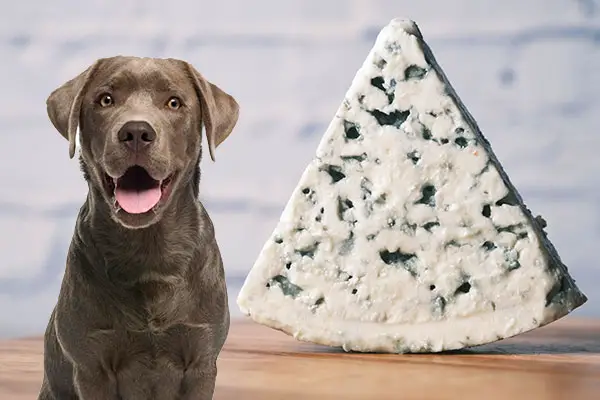Dogs are not the fussiest eaters of all household pets. That title goes to cats. On the contrary, dogs can be fairly enthusiastic eaters.
Most dogs will develop an immediate interest in unfamiliar foods. That includes dairy products like cheese and yogurt. However, many foods considered safe for human consumption may not be so safe for our canine friends.
If you’re a blue cheese lover and are constantly toying with the idea of sharing some slices of your cheesy treats with your pooch, it’s probably best to reconsider. That brings us back to our question, can dogs eat blue cheese?
Cheese, in general, isn’t immediately toxic to dogs. But certain cheese types, such as blue cheese, is an exception to that rule. Blue cheese contains funguses that could make your dog sick. Symptoms can range from vomiting and diarrhea to tremors and seizures. And without immediate intervention, symptoms of blue cheese poisoning in dogs could degenerate to life-threatening levels.
So, can dogs have blue cheese?
Dogs should avoid blue cheese at all costs. Although plain cheese isn’t considered to be immediately toxic to dogs, the process of manufacturing blue cheese renders it potentially harmful to your canine friend.
This article delves deeper into the possible effects of blue cheese in dogs.
What Is Blue Cheese?
Blue cheese, also known as bleu cheese, is a type of semi-soft cheese typically made using cultures of the mold Penicillium. It’s these mold cultures that give the cheese its bluish spots. The spots can vary in color, ranging from various shades of blue to green and even grey.
Types of Blue Cheese
Blue cheese comes in several types. Notable ones include;
- Danablu blue cheese
- Gorgonzola blue cheese
- Roquefort blue cheese
- Stilton blue cheese
Despite the type, all blue cheese share fundamental traits. That include their fermentation process, taste, flavor, and application.
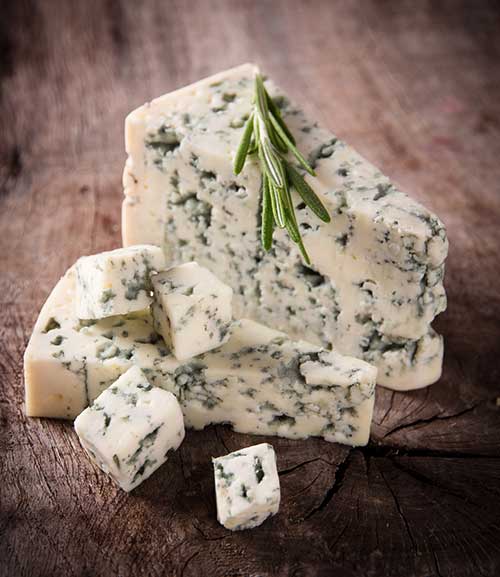
How Is Blue Cheese Manufactured?
Blue cheeses are usually aged in temperature-controlled environments, such as a cave. Two of the most commonly-used bacteria include Penicillium roqueforti and Brevibacterium linens.
The process generally begins with the injection of Penicillium roqueforti into plain cheese. This can happen before or after the formation of the curds.
The next step involves sprinkling of fungus salt. This is done to preserve the cheese’s shelf life.
Lastly, the cheese is left for 60 to 90 days, during which it will start to develop the colored spots. After this period, your blue cheese will be ready for consumption.
How Does Blue Cheese Smell?
Blue cheese has a distinct smell. The smell mainly comes from various mold and bacterial cultures used in fermenting the cheese.
What Does Blue Cheese Taste Like?
Blue cheese typically has a sharp salty taste. Again, the flavor has a lot to do with the specific mold and bacteria used in preparing the cheese.
How Is Blue Cheese Consumed?
Like most cheese types, blue cheese can be eaten either as a standalone meal or used as a spread. The cheese can also be crumbled or melted and used with a range of other foods.
And for your peace of mind, it’s worth noting that the mold used in preparing blue cheese is quite different from the regular molds growing on stale bread. Unlike the latter which can produce potentially toxic chemicals known as mytcotoxins, the molds used in blue cheese have been carefully processed to eliminate any risks of disease.
- Sourced and Made in USA: Each small batch of our made in USA dog treats is freeze dried under our own roof in Dayton, Ohio to use with confidence…
- Quality Ingredients: The only ingredient in this recipe is USDA certified, human grade cheddar cheese so these treats are all natural, grain free,…
- High Value Reward: Made with 100 percent real, reduced fat cheddar cheese, our treats are packed with protein, vitamins, and nutrients such as…
Last update on 2025-01-10 / Affiliate links / Images from Amazon Product Advertising API
Is Blue Cheese Good For Dogs?
We’ve already highlighted that blue cheese is perfectly safe for human consumption. In fact, blue cheese can offer several health benefits to humans.
But can we say the same about our canine friends? Is blue cheese ok for dogs?
Blue cheese isn’t recommended for dogs. Your pooch will unlikely drop dead from consuming blue cheese. But there are always dangers to be wary of.
The following section expounds further on the potential risks of blue cheese to dogs.
What Makes Blue Cheese Harmful To Dogs?
The potential toxicity of blue cheese to dogs comes from the fungi used while manufacturing the cheese. The molds and bacterial cultures used in blue cheese can lead to the formation of a substance known as Roquefortine C. It’s this compound that’s responsible for many of the adverse effects of blue cheese in dogs.
Exposure to Roquefortine C can present a range of symptoms. Common ones include;
- Nausea
- Vomiting
- Diarrhea
- Appetite loss
- Dehydration
- Abdominal pain
These symptoms can degenerate into more severe side effects, including;
- Fever
- Restlessness
- Disorientation
- Elevated heart rate
- Tremors
- Seizures
And without timely medical intervention, your dog could enter into a coma and even die.
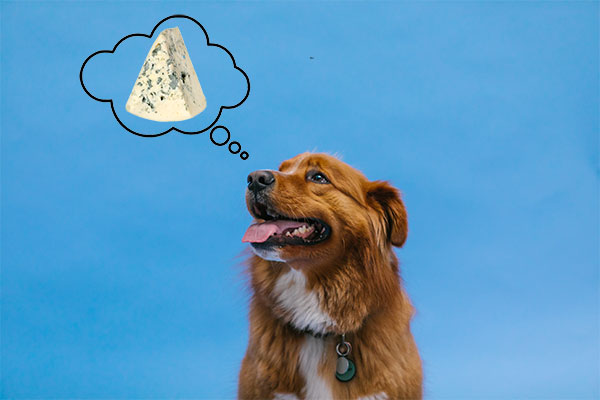
The following are other potential issues with blue cheese for dogs besides Roquefortine C;
1. Fat-related Concerns
Blue cheese tends to be worryingly high in fats and calories. A single ounce of blue cheese can have up to 99 calories and over 90% fat content.
Fatty foods are infamous for their tendency to induce unintentional weight gain. Consuming excess fats might also trigger a laxative effect, leading to diarrhea and dehydration.
Blue cheese is particularly discouraged for physically inactive dog breeds as well as dogs who are already overweight. High-fat diets may also exacerbate the symptoms of obesity, pancreatitis, heart disease, and diabetes.
If you’re living with a diabetic dog and also happen to be a blue cheese lover, it’s not unusual to occasionally find yourself wondering, can diabetic dogs eat blue cheese?
As we’ve just pointed out, diabetic dogs shouldn’t eat blue cheese. Blue cheese is laden with fats that could worsen the symptoms of diabetes and a host of other chronic diseases.
2. Lactose Intolerance
Many dogs are lactose intolerant.
Lactose intolerance is a name for the symptoms that result from consuming a product containing the simple sugar lactose. The condition occurs in animals that lack enough lactase – the enzyme that breaks down lactose – in their system.
Common symptoms of lactose intolerance include;
- Nausea
- Vomiting
- Diarrhea
- Bloating
- Abdominal pain and discomfort
- Real meat is the number 1 ingredient. Meaty taste and cheesy flavor for an irresistible treat
- Bacon flavor treats for dogs made with real bacon. The original strip that started it all, plus the yummy flavor of cheese
- A texture is easy to chew. Mouthwatering bacon flavored treats to tempt your dog
Last update on 2025-01-17 / Affiliate links / Images from Amazon Product Advertising API
3. Salt Poisoning
Consuming high amounts of salt is associated with a condition known as salt-ion poisoning or sodium-ion poisoning. Unfortunately, blue cheese tends to be considerably high in salt.
Salt-ion poisoning can cause damage to your dog’s kidneys. That’s the main reason dogs with kidney disease shouldn’t eat blue cheese.
Some of the tell-tale signs that your dog has consumed excess sodium include;
- Nausea and vomiting
- Diarrhea leading to dehydration
- Frequent drinking due to dehydration
- Frequent urination
- Dizziness
Sodium ion poisoning might also lead to a coma if not diagnosed and treated early enough.
4. Problems With Other Additives
Like other cheese types, blue cheese usually contains several additives. These can range from spices like onion and garlic, to nuts like macadamia, and even fruits like avocado and grapes.
Some of these additives, particularly garlic and onion, might trigger severe health issues in dogs. Studies have shown that onion and garlic can cause a type of hemolytic anemia in cats and dogs, known as Heinz-body anemia.
Heinz-body anemia destroys red blood cells, adversely affecting the supply of oxygenated blood and essential nutrients to various body parts. The condition typically manifests in anemia-like symptoms, such as skin and gum paleness. Without timely intervention, Heinz-body anemia may lead to seizures, coma, and eventually death.
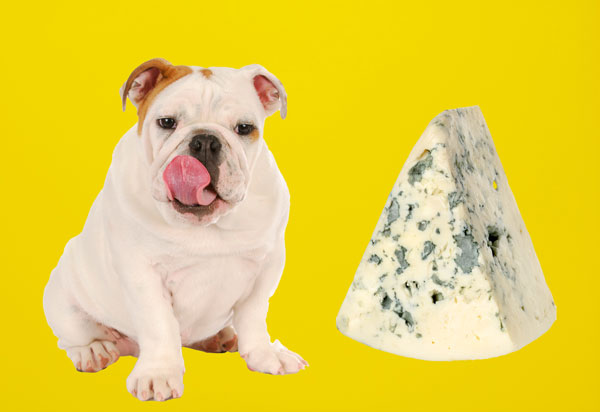
Are Dogs Allergic To Blue Cheese?
Cheese allergies are common, not only in humans but pets alike. Therefore, it’s logical to assume that your dog could develop allergic reactions from consuming blue cheese.
Signs of allergy can range from symptoms of gastrointestinal upset to respiratory issues and even skin-related symptoms. The severity of these symptoms mainly depends on the amount of blue cheese your canine housemate has consumed.
Here are common symptoms of blue cheese allergy in dogs;
- Nausea and vomiting
- Diarrhea and appetite loss
- Dehydration
- Labored breathing
- Coughing, sneezing, and/or wheezing
- Runny eyes and/or nose
- Excessive drooling or hypersalivation
- Irritability
- Withdrawal
- Itching of the skin
Is Blue Cheese Safe For Dogs?
Blue cheese isn’t safe for dogs. The bacteria and fungi used in fermenting the cheese produce Roquefortine C, which can be toxic to dogs.
Besides Roquefortine C, blue cheese contains several other ingredients that make it unsafe for your canine friend. These include fat, lactose, salt, and spices.
Is Blue Cheese Bad For Dogs?
There’s a range of things that could go wrong if you fed blue cheese to your dog. These adverse effects come from Roquefortine C and many chemical additives in the cheese.
Needless to mention, your dog could also develop hypersensitive reactions to blue cheese. So, blue cheese is bad for dogs.
Perhaps you’ve just shared blue cheese with your pooch and are now wondering, ‘my dog ate blue cheese, will he get sick?’
Yes, your dog will likely get sick from eating blue cheese. The severity of effects will depend on the amounts consumed.
- Helps When Nature Calls – These chicken-flavored treats contain Pumpkin and Bromelain, which have properties that support regularity and overall…
- Premium Digestive Support – Zesty Paws Advanced Probiotic Bites feature Prebiotics, Probiotics, and Digestive Enzymes to aid digestion, immune…
- Featuring PreforPro Prebiotic – Each chew contains 4mg of PreforPro, which is a premium pet Prebiotic that’s clinically proven to support healthy gut…
Last update on 2024-12-17 / Affiliate links / Images from Amazon Product Advertising API
Is Blue Cheese Toxic To Dogs?
Even after reviewing the numerous potential risks of blue cheese to dogs, you could still be wondering, is blue cheese poisonous to dogs?
Blue cheese contains Roquefortine C. This substance is known to be poisonous to dogs.
Is blue cheese dangerous for dogs then?
Yes, it is. The presence of Roquefortine C is the main thing that makes blue cheese dangerous for dogs. And depending on how the cheese is prepared, it may also contain additional compounds known to be harmful to dogs. These include salt, fat, lactose, and spices.
Can Blue Cheese Kill Dogs?
Your dog may not drop dead the moment he consumes blue cheese. However, the resulting symptoms could be fatal if not addressed with the urgency they deserve.
That underscores the importance of timely interventions if you suspect that your dog has eaten blue cheese.
Are Some Dogs More Vulnerable To Blue Cheese Adverse Effects Than Others?
Puppies are known for their highly sensitive stomachs. Anything that could potentially harm dogs in general tends to be even more dangerous for puppies.
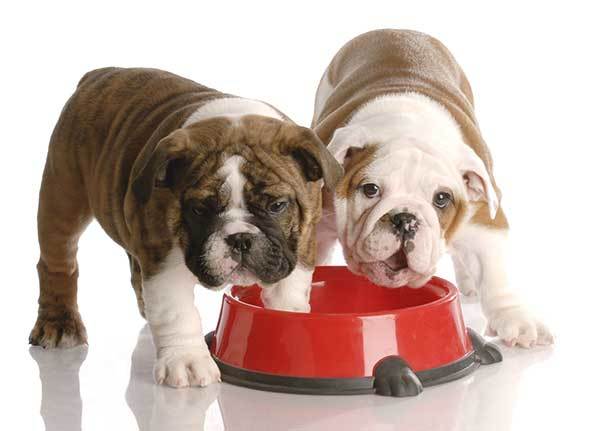
That begs the question, can puppies eat blue cheese?
Puppies should avoid blue cheese. Not only can puppies suffer the general adverse effects of blue cheese in dogs. But they’ll experience even more severe symptoms due to their more sensitive digestive tracts.
The only saving grace would be the fact that pups are less lactose intolerant than mature dogs. That’s because puppies are capable of secreting the enzyme lactase up to a certain point. However, blue cheese contains tons of other ingredients that could still cause severe health issues to your pups. So, total avoidance is your best bet.
In addition to puppies, the following category of dogs shouldn’t eat blue cheese;
1. Senior Dogs
Old age comes with its challenges, one of which is reduced immunity. That’s the primary reason senior dogs shouldn’t eat blue cheese. They may suffer more severe negative consequences than their middle-aged counterparts.
Besides, senior dogs tend to be less active. Considering that blue cheese is so high in fat, even a tiny amount could induce unintentional weight gain.
2. Sick Dogs
Sickness suppresses immunity. Therefore, sick dogs shouldn’t eat blue cheese.
That includes dogs with chronic illnesses and those recovering from surgical procedures. It also entails pregnant dogs and nursing dogs.
In the case of chronic illnesses, dogs with obesity, diabetes, kidney disease, pancreatitis, and heart disease should particularly avoid blue cheese completely. That’s because blue cheese (and cheese in general) has been shown to exacerbate the symptoms of these conditions.
3. Hypersensitive Dogs
Dog allergies are common. If your dog has exhibited allergic reactions to dairy products before, then you should avoid feeding him any blue cheese. There’s a high likelihood that your pooch could be lactose intolerant.
- Works as a dog food topper – For pet parents looking for an alternative to capsules, raw treats, or soft chews, all it takes is a few pumps of Salmon…
- A tasty & body nourishing treat for cats & dogs – Essential fatty acids for a healthy coat.
- Powerful Omega Fatty Acids – This premium fish oil liquid formula is loaded with the healthy Omega-3 fatty acid (with epa and dha) to support health…
Last update on 2025-01-15 / Affiliate links / Images from Amazon Product Advertising API
Does It Matter The Type And Part Of Blue Cheese Your Dog Eats?
Blue cheese is inherently bad for dogs regardless of the type or part eaten. But as you shall find, certain blue cheese types and parts could be even more toxic for your pooch;
Can dogs eat blue Stilton cheese?
Stilton is a popular blue cheese variety. It’s also one of the many blue cheese types that dogs shouldn’t eat.
Can dogs eat Danish blue cheese?
Dogs shouldn’t eat Danish blue cheese. That’s because this cheese type contains most of the blue cheese ingredients known to be toxic to dogs.
Can dogs eat blue cheese crumbles?
It doesn’t matter whether it’s crumbled, melted, or otherwise formulated. Blue cheese remains potentially harmful to dogs.
Can dogs eat blue cheese dressing?
Most ingredients used as blue cheese dressing are toxic to dogs. These range from salt and spices to fruits and nuts.
Can dogs eat blue vein cheese?
Blue vein cheese is just another term for blue cheese. So, dogs shouldn’t have it either.
What to Do If My Dog Ate Blue Cheese
It’s not enough to know what happens when your dog eats blue cheese. It’s equally important to understand what to do in the event your pooch helps himself to blue cheese behind your back.
First off, you should start by establishing the amount of blue cheese consumed. As we already mentioned, the severity of symptoms depend on the total quantity consumed.
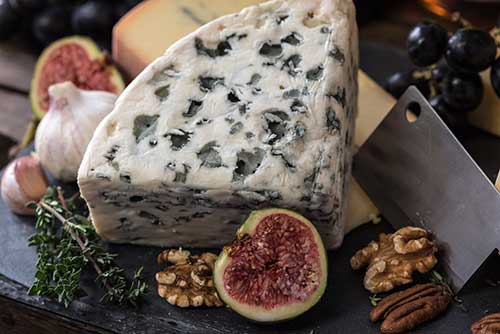
One of the frequently asked questions among dog owners who also happen to be blue cheese loves is, ‘my dog ate a large hunk of blue cheese, is it toxic?
A huge hunk of cheese will undoubtedly be toxic to your dug. But then you could be wondering, how much blue cheese is bad for dogs and can dogs eat small amount of blue cheese?
There’s no standard of measure for determining the right blue cheese quantity to feed to dogs. Blue cheese is inherently bad for dogs regardless of the amount fed.
But if you’re adamant about sharing blue cheese with your pooch, you could be wondering – how much blue cheese should your dog have?
The best answer to this question is to practice moderation. If you must share blue cheese with your canine friend, keep the portions low.
Also, only give your dog blue cheese as an occasional treat or as a way of getting the animal to consume his meds.
Perhaps you’ve one time found yourself wondering, ‘my dog ate small amount of blue cheese, will he be okay?’
Again, blue cheese is potentially harmful to dogs regardless of the portions served. But if you insist on sharing this cheese with your pooch, then experiment with small amounts.
Most importantly, remember to schedule a visit to the vet immediately if your dog develops symptoms of blue cheese poisoning.
Conclusion
Blue cheese may not pose immediate health concerns to dogs. However, the cheese is highly discouraged due to the toxic substance Roquefortine C. Besides, blue cheese may contain numerous other ingredients known to be toxic to dogs, including fat, salt, spices, and lactose.
- Contains (4) 12 Ounce Bags Of Grain Free Dog Treats
- Made with real USA-sourced lamb as the #1 ingredient
- No fillers, No Wheat, No corn, No artificial flavors or preservatives
Last update on 2025-01-10 / Affiliate links / Images from Amazon Product Advertising API
Checkout Our Favorite Dog Products
1. BEST PUPPY TOY
We Like: Snuggle Behavior Toy with Heart Beat & Heat Pack – Ideal toy for new puppies.
2. BEST DOG TRAINING PROGRAM
We Like: Doggy Dan The Online Dog Trainer – Stop any dog problem and raise the perfect puppy with The Online Dog Trainer.
3. Best Multivitamin for Dogs
We Like: PetHonesty 10-For-1 Multivitamin – 10 Benefits in 1 Daily Treat – These Multivitamin Snacks combine a well-rounded blend of the most essential vitamins and supplements including glucosamine, probiotics, vitamins and omegas, for dogs’ overall daily health.
4. BEST DOG PUZZLE TOY
We Like: Outward Hound Interactive Puzzle Toy – Every dog loves chasing squirrels at the park. The Outward Hound Hide-a-Squirrel Puzzle Toy gives your dog the same feeling as though he was outdoors chasing live squirrels.
5. Best Calming Treats for Dogs
We Like: FurroLandia Hemp Calming Treats – These soft chews will calm your dog so it can peacefully endure stressful situations, such as long car trips, visiting unfamiliar places, or hearing Thunder. Ideal for all dog breeds & sizes.

